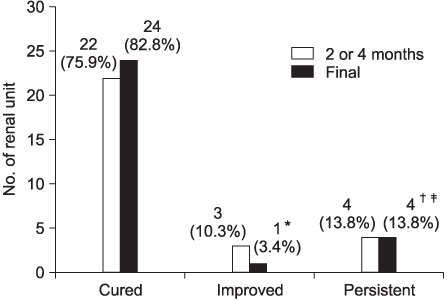Korean J Urol.
2007 Jan;48(1):82-86. 10.4111/kju.2007.48.1.82.
Experience of Subureteral Polydimethylsiloxane Injection Treatment in Children with Vesicoureteral Reflux
- Affiliations
-
- 1Department of Urology, Sungkyunkwan University School of Medicine, Seoul, Korea. khpark@smc.samsung.co.kr
- KMID: 1915027
- DOI: http://doi.org/10.4111/kju.2007.48.1.82
Abstract
-
PURPOSE: Our data was retrospectively reviewed to assess the efficacy, safety and costs of endoscopic subureteral polydimethylsiloxane (PDS, Macroplastique(R)) injection treatment for children with vesicoureteral reflux (VUR).
MATERIALS AND METHODS
Between December 1997 and May 2006, a total of 24 (29 renal units) VUR patients, whose parents showed reluctance toward open surgery, underwent subureteral PDS injection treatment. All of the patients were postoperatively assessed by voiding cystourethrography (VCUG) and ultrasound to evaluate any complications and reflux. The medical costs of the injection treatment were compared with those of open surgery for VUR over the same period.
RESULTS
The mean follow-up was 15 months (range 2-72). Of the 29 renal units treated, 24 (82.8%) were cured. Hydronephrosis, which postoperatively developed in three renal units, was spontaneously improved or resolved after minimal endourological procedures. Temporary gross hematuria and voiding difficulty occurred in one patient each, but were also improved. The total medical costs of the injection treatment were cheaper than those of open surgery (p<0.05).
CONCLUSIONS
An endoscopic subureteral PDS injection is an effective and safe procedure; in addition, compared to open surgery, is an economic treatment for children with VUR.
Keyword
MeSH Terms
Figure
Cited by 1 articles
-
Effect of Subureteral Injection of Polydimethylsiloxane (PDS) in Children with Vesicoureteral Reflux
Sun-Ouck Kim, Jae-Sang Joo, Chang Min Im, Kyung-Jin Oh, Seung-Il Jung, Taek Won Kang, Dongdeuk Kwon, Kwangsung Park, Soo-Bang Ryu
Chonnam Med J. 2008;44(1):48-52. doi: 10.4068/cmj.2008.44.1.48.
Reference
-
1. Matouschek E. Treatment of vesicorenal reflux by transurethral teflon-injection. Urologe A. 1981. 20:263–264.2. O'Donnell B, Puri P. Treatment of vesicoureteric reflux by endoscopic injection of Teflon. Br Med J. 1984. 289:7–9.3. Puri P, O'Donnell B. Correction of experimentally produced vesicoureteric reflux in the piglet by intravesical injection of teflon. Br Med J. 1984. 289:5–7.4. Dodat H, Valmalle AF, Weidmann JD, Collet F, Pelizzo G, Dubois R. Endoscopic treatment of vesicorenal reflux in children. Five-year assessment of the use of macroplastique. Prog Urol. 1998. 8:1001–1006.5. Herz D, Hafez A, Bagli D, Capolicchio G, McLorie G, Khoury A. Efficacy of endoscopic subureteral polydimethylsiloxane injection for treatment of vesicoureteral reflux in children: a north american clinical report. J Urol. 2001. 166:1880–1886.6. Kim HC, Shim KS, Moon DG. The early experience and technical aspects of endoscopic subureteral polydimethylsiloxane injection for vesicoureteral reflux. Korean J Urol. 2006. 47:154–159.7. Ji YH, Kim HS, Choo MS. Effect of subureteral injection of polydimethylsiloxane in women with vesicoureteral reflux. Korean J Urol. 2002. 43:1014–1018.8. Park JW, Kim KS. An experience of endoscopic polydimethylsiloxane injection for the treatment of vesicoureteral reflux in children. Korean J Urol. 2003. 44:150–154.9. Joyner BD, Atala A. Endoscopic substances for the treatment of vesicoureteral reflux. Urology. 1997. 50:489–494.10. Bhatti HA, Khattak H, Boston VE. Efficacy and causes of failure of endoscopic subureteric injection of teflon in the treatment of primary vesicoureteric reflux. Br J Urol. 1993. 71:221–225.11. Smith DP, Kaplan WE, Oyasu R. Evaluation of poly dimethylsiloxane as an alternative in the endoscopic treatment of vesicoureteral reflux. J Urol. 1994. 152:1221–1224.12. Cukier J, Beauchamp RA, Spindler JS, Spindler S, Lorenzo C, Trentham DE. Association between bovine collagen dermal implants and a dermatomyositis or a polymyositis-like syndrome. Ann Intern Med. 1993. 118:920–928.13. Oswald J, Riccabona M, Lusuardi L, Bartsch G, Radmayr C. Prospective comparison and 1-year follow-up of a single endoscopic subureteral polydimethylsiloxane versus dextranomer/hyaluronic acid copolymer injection for treatment of vesicoureteral reflux in children. Urology. 2002. 60:894–897.14. Ozyavuz R, Ozgur GK, Yuzuncu AK. Subureteric polydimethylsiloxane injection in the treatment of vesico-ureteric reflux. Int Urol Nephrol. 1998. 30:123–126.15. van Capelle JW, de Haan T, El Sayed W, Azmy A. The long-term outcome of the endoscopic subureteric implantation of polydimethylsiloxane for treating vesico-ureteric reflux in children: a retrospective analysis of the first 195 consecutive patients in two European centres. BJU Int. 2004. 94:1348–1351.16. Elder JS, Diaz M, Caldamone AA, Cendron M, Greenfield S, Hurwitz R, et al. Endoscopic therapy for vesicoureteral reflux: a meta-analysis. I. Reflux resolution and urinary tract infection. J Urol. 2006. 175:716–722.17. Lee PH, Diamond DA, Duffy PG, Ransley PG. Duplex reflux: a study of 105 children. J Urol. 1991. 146:657–659.18. Caldamone AA. Duplication anomalies of the upper tract in infants and children. Urol Clin North Am. 1985. 12:75–91.19. Aboutaleb H, Bolduc S, Khoury AE, Upadhyay J, Bagli DJ, Farhat W. Polydimethylsiloxane injection versus open surgery for the treatment of vesicoureteral reflux in complete duplex systems. J Urol. 2003. 170:1563–1565.20. Ross JH, Kay R, Nasrallah P. Contralateral reflux after unilateral ureteral reimplantation in patients with a history of resolved contralateral reflux. J Urol. 1995. 154:1171–1172.21. Kumar R, Puri P. Newly diagnosed contralateral reflux after successful unilateral endoscopic correction: is it due to the pop-off mechanism? J Urol. 1997. 158:1213–1215.22. Aboutaleb H, Bolduc S, Upadhyay J, Farhat W, Bagli DJ, Khoury AE. Subureteral polydimethylsiloxane injection versus extravesical reimplantation for primary low grade vesicoureteral reflux in children: a comparative study. J Urol. 2003. 169:313–316.
- Full Text Links
- Actions
-
Cited
- CITED
-
- Close
- Share
- Similar articles
-
- An Experience of Endoscopic Polydimethylsiloxane Injection for the Treatment of Vesicoureteral Reflux in Children
- Effect of Subureteral Injection of Polydimethylsiloxane in Women with Vesicoureteral Reflux
- The Early Experience and Technical Aspects of Endoscopic Subureteral Polydimethylsiloxane Injection for Vesicoureteral Reflux
- Effect of Subureteral Injection of Polydimethylsiloxane (PDS) in Children with Vesicoureteral Reflux
- Technical Considerations of Endoscopic Subureteral Injection for the Treatment of Vesicoureteral Reflux


